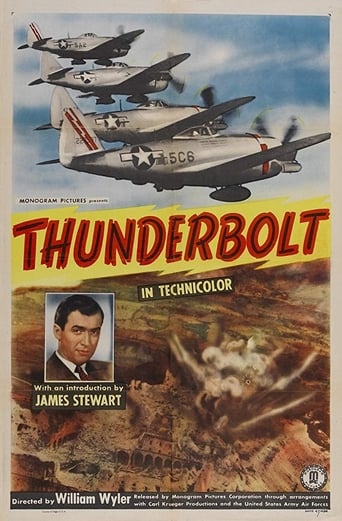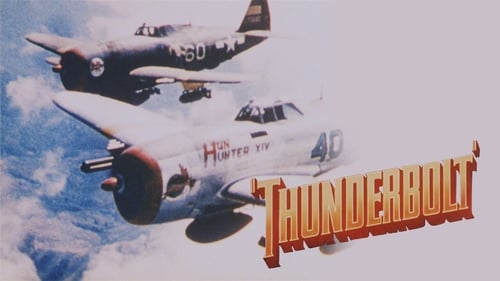Jeanskynebu
the audience applauded
Plustown
A lot of perfectly good film show their cards early, establish a unique premise and let the audience explore a topic at a leisurely pace, without much in terms of surprise. this film is not one of those films.
AshUnow
This is a small, humorous movie in some ways, but it has a huge heart. What a nice experience.
Myron Clemons
A film of deceptively outspoken contemporary relevance, this is cinema at its most alert, alarming and alive.
robertguttman
William Wyler began work on this film during 1944 as a counterpoint to his better-known film about the 8th Air Force, "Memphis Belle". While the latter concerned the strategic bombing campaign carried out by long-range, multi-engine bombers, the subject of "Thunderbolt" was tactical missions flown by single-engine, single-seat fighter-bombers. This was a very different war from that depicted in "Memphis Belle". For one thing, while strategic bomber crews could expect to be rotated home after completing 25 missions, the fighter-bomber pilots were flying literally hundreds of missions, frequently carrying out several during the course of a single day. The film chronicles a brief period with one of several fighter-bomber groups based on the island of Corsica, about 60 miles west of the Italian mainland. Incidentally, this was the same island where Joseph Heller was based, and which inspired him to write his famous novel, "Catch-22". The only difference is that "Thunderbolt" was not filmed with a Medium Bomber Group, such as Heller served in, but with a Fighter-Bomber Group. The fighter-bombers featured in the film are P-47s, to which the Army Air Force gave the emotive name of "Thunderbolt". However, to those who flew them, the P-47 was invariably known as "The Jug", partly due to it's rotund shape, but more especially as a contraction of the word "Juggernaut". For a Juggernaut was precisely what the P-47 was. The Jug was the largest single-seat fighter to serve during WW-II. It carried eight 12.7-mm machine guns along with a heavy load of bombs or rockets, and was capable of bringing it's pilot home after absorbing a considerable amount of battle damage. Unlike any other fighters of that time the Jug had an air-cooled engine, which meant that it's pilot did not have to worry about a liquid cooling system that was vulnerable to damage from enemy fire. Because of those characteristics the Jug came into it's own in the sort of low-level ground-attack missions shown in "Thunderbolt". In fact years later, when they began flying similar ground attack missions in Korea, a lot of veteran pilots regretted the fact that the Air Force had seen fit to scrap all of it's Jugs after WW-II ended."Thunderbolt" does not glamorize the lives of these fighter-bomber personnel. The narration is as terse as the subject matter. It was a brutal war, and that brutality is not watered down. To the men of the Fighter-Bomber Group this was merely a day-to-day job, with the difference that the working men shown in the film did not always live to see the next day. However, the film does go out of it's way to explain exactly what it was that they were trying to accomplish, and why it mattered. It is interesting to reflect that The Big Picture was something many of the members of the Fighter-Bomber Group probably did not entirely understand at the time. In short, these aircraft were engaged in cutting Italian road and rail communications in order to prevent the movement of war material to the German Army, so that the Allied Armies could break the stalemate in the mountains of Southern Italy. The mere fact that the stalemate was broken is proof of how effective the air campaign shown in the film actually was.
Red-Barracuda
The setting is the Italian Campaign in World War Two. More specifically this is about a series of planned air strikes carried out using the P-47 Thunderbolt bombers launched from Corsica in 1944 that went under the codename Operation Strangle. The idea was to destroy the bridges, train tracks and vehicles on the roads at the narrowest section of the Italian peninsula, which in effect would cut off supplies to the German army located in the South of that country, allowing the Allies to advance big distances north.Like other wartime documentaries such as Attack in the Pacific (1944) this film shares similar strengths and weaknesses. On the one hand, it's obviously very raw, one-sided and propagandist to an extent. But on the other hand, it has a lot of fascinating real footage. This included planes fitted out with multi-camera set ups involved in the missions. We witness attacks on various targets which show pretty clearly the dangers involved. This also includes some indiscriminate bombings, where farmhouses seem to have been routinely blown up in case they were holding explosives, etc. We also see footage of the real men involved which adds an extra poignancy. You will get a more detailed overview of events in a documentary made nowadays but there is still some invaluable footage here. And it was a very important campaign to the overall war effort, so it's good to see it being documented for that reason alone.
oscar-35
*Spoiler/plot- 1947, A film showing the operations of a fighter/bomber air wing group flying from Sardinia to Italy to support the Italian Allied campaign.*Special Stars- Director: John Sturges. Narrator: Robert Lowery. Pilot's voice: Lloyd Bridges *Theme- Airpower is crucial in operations.*Trivia/location/goofs- Filmed in Sardinia. Look for the best film representations of Christmas holidays celebrated in the rear areas by troops of the WW2 period.*Emotion- An enjoyable documentary made up of live action combat or newsreel footage. It gives you the tone and feel of the times for WW2 fighter pilots. However, there are the unpleasant shots of injured Americans with some blatant racist language. But it is extremely educational and does what a narrative simulated war film can do.
cmfarrar
Often times film making from the war slips into propaganda and flag waving. This film instead shows the cold hard truth of a fighter group working out of Corsica in 1944. The personal, humanized glimpses of real men instead of lantern jawed actors as they go on about their days, living their daily lives worrying about who won't come back. The shooting style is from on board cameras from several points on the planes and shows so many real mission realities from a normal fighter sweep over Italy including coldly shooting up innocent farmhouses in search of one that's not so innocent and plowing any thing that moves in the daylight.At some point as you watch this you go through so many emotions from the shock of realizing just how young these pilots are to being mystified about how they can be so cold as they light up the Italian country side to a sad understanding as director William Wyler shows you what would never be shown in a Frank Capra's "Why We Fight" movies, the charred body of a Jug pilot being pulled from the burning wreckage of his fighter with a hook. The end scene of the pilots and crews falling over drunk makes complete sense.This film is much more poignant than Wyler's later film "Memphis Belle" which while good shows the touch of war time censors. Released in 1945, after the war in Europe was over, "Thunderbolt" drives home the very humancosts of war.


